Read Time: 7 Minutes Subscribe & Share
Once Upon A Time
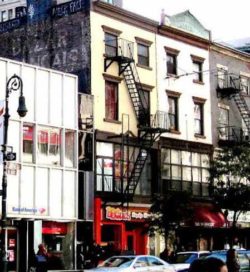 The first copper cookware we had at La Cuisine when it opened in October 1970 was manufactured in the USA — right under the Brooklyn Bridge, in fact. I had decided to take the plunge and run a cookware store that reflected the quality of cookware that I saw in Europe, not just a cute little shop with a kitchen gadget moniker. I sought the advice of an American woman who ran a successful cookware store in Georgetown called “Ann’s Kitchen”. She later sold it to a French couple who ran it under the name of “The French Kitchen.” Ann Taylor recommended that I put myself in the hands of a very knowledgeable woman who ran a beautiful show room at 225 Fifth Avenue in Manhattan. It was the wholesale showroom of a premier cookware store, “Bazar Francais”, which had been the go-to shop for professional culinary equipment in New York since 1929.
The first copper cookware we had at La Cuisine when it opened in October 1970 was manufactured in the USA — right under the Brooklyn Bridge, in fact. I had decided to take the plunge and run a cookware store that reflected the quality of cookware that I saw in Europe, not just a cute little shop with a kitchen gadget moniker. I sought the advice of an American woman who ran a successful cookware store in Georgetown called “Ann’s Kitchen”. She later sold it to a French couple who ran it under the name of “The French Kitchen.” Ann Taylor recommended that I put myself in the hands of a very knowledgeable woman who ran a beautiful show room at 225 Fifth Avenue in Manhattan. It was the wholesale showroom of a premier cookware store, “Bazar Francais”, which had been the go-to shop for professional culinary equipment in New York since 1929.
On what was once known as part of the “ladies mile,” Charles Ruegger bought a building at 666 6th Avenue and evolved from selling building supplies to professional cookware, long before the arrival of 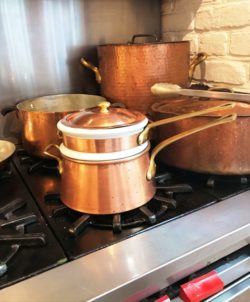 J.B Prince (one of my favorite cookware sources) or Bridge Kitchenware. His son, grandson, and great grandson, all named Charles Ruegger, continued running this successful enterprise with Bruno Waldow, a
J.B Prince (one of my favorite cookware sources) or Bridge Kitchenware. His son, grandson, and great grandson, all named Charles Ruegger, continued running this successful enterprise with Bruno Waldow, a 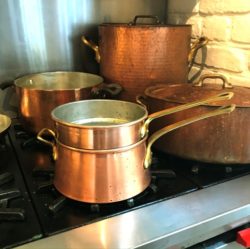 German immigrant and master coppersmith, collaborating to create a distinct line of copper cookware that could compete with those produced in France. In what my daughter would call a karma spanking, the last Charles, who had inherited a thriving business, later wasted the profits of Bazar Francais to such a degree that he apparently ended up working for Bruno Waldow to pay off some of the debts. Bruno designed some unique pieces under the “666” logo, a couple of which I have today. Perhaps the most iconic piece is his double boiler, which came in two sizes and could be purchased with either a tin-lined copper insert or a ceramic insert. The base pan, because of its slope, keeps water from evaporating too quickly and prevents hot oil from spattering when it serves as my beef fondue pot. The Resident Wine Maniac continues to make his divine Hollandaise and Bearnaise sauces in it today.
German immigrant and master coppersmith, collaborating to create a distinct line of copper cookware that could compete with those produced in France. In what my daughter would call a karma spanking, the last Charles, who had inherited a thriving business, later wasted the profits of Bazar Francais to such a degree that he apparently ended up working for Bruno Waldow to pay off some of the debts. Bruno designed some unique pieces under the “666” logo, a couple of which I have today. Perhaps the most iconic piece is his double boiler, which came in two sizes and could be purchased with either a tin-lined copper insert or a ceramic insert. The base pan, because of its slope, keeps water from evaporating too quickly and prevents hot oil from spattering when it serves as my beef fondue pot. The Resident Wine Maniac continues to make his divine Hollandaise and Bearnaise sauces in it today.
The Right Stuff
While France has been the mothership of superior copper cookware, the torch of Bruno Waldow flickers on among the small group of truly dedicated producers of what I call correct copper cookware. This is not to be confused with my mother’s copper(ish)-bottomed Revereware – which was sold to a couple of generations of home cooks, and bears no resemblance to the real thing. Also not to be confused with any of the copper-clad, or copper-striped cookware that gets designed and marketed in the US. So let’s settle on some scientific data as to why properly designed and fabricated copper cookware is superior to its competitors.
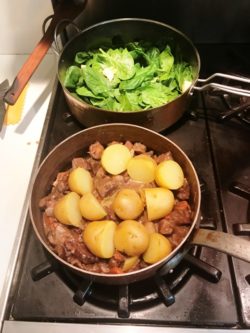 Copper itself has an antibacterial effect. It is toxic to viral germs and bacteria, which is why water pipes and door handles in hospitals were often made of copper. Since cooking is basically all about heat transfer, you should know that copper conducts heat five times more effectively than iron and twenty-five times more effectively than stainless steel. Heat spreads out evenly and quickly, and scorching or over-searing is lessened dramatically in comparison to other alloys. With just a bit of butter or oil, it is virtually non-stick. If you raise or lower your heat source, copper responds remarkably quickly. Another benefit is that cooking with copper uses fewer BTUs. You can reach the desired effect sautéing or simmering and not waste your heat source. In the end, your Hollandaise, when removed from the heat in copper, won’t keep on cooking (and curdling) as it would in a less responsive metal or clay.
Copper itself has an antibacterial effect. It is toxic to viral germs and bacteria, which is why water pipes and door handles in hospitals were often made of copper. Since cooking is basically all about heat transfer, you should know that copper conducts heat five times more effectively than iron and twenty-five times more effectively than stainless steel. Heat spreads out evenly and quickly, and scorching or over-searing is lessened dramatically in comparison to other alloys. With just a bit of butter or oil, it is virtually non-stick. If you raise or lower your heat source, copper responds remarkably quickly. Another benefit is that cooking with copper uses fewer BTUs. You can reach the desired effect sautéing or simmering and not waste your heat source. In the end, your Hollandaise, when removed from the heat in copper, won’t keep on cooking (and curdling) as it would in a less responsive metal or clay.
Tin is the traditional lining for copper so that food does not turn green if left in the pan for a long time. Tin melts at 230C or 450F. We have unnamed guilty parties in my house who have managed to melt the lining. I just let it harden again, and if there are some uneven spots, it really makes no difference in cooking. It took a long time to develop a stainless lining that would adhere to a thick sheet of copper, an expensive process that was initially developed by a German company. Most copper cladding here is a “skin” of copper bonded to a stainless sheet – which then makes the copper a cosmetic add-on rather than a functional part of the cookware. There is an underground current of quibbling over the tin vs. stainless lining. Since I have both, what I notice is that the response to heat differences is quicker with tin than it is with stainless steel. A final note on investing in copper cookware is that my pieces, unlike the coated ones, have been used hard for over forty years in my kitchen and have never been replaced.
The US Players in Copper Cookware
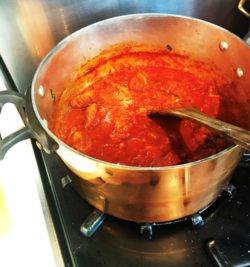 The legacy of Bruno Waldow left its mark on the founders of Hammersmith (the partners bought the business from Bruno) and Mac Kohler, the
The legacy of Bruno Waldow left its mark on the founders of Hammersmith (the partners bought the business from Bruno) and Mac Kohler, the 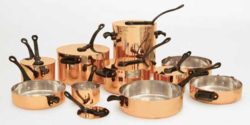 founder of Brooklyn Copper Company. Mac’s company is the only one in the US that is dedicated to my favorite gauge of copper (2.3mm to 3.2mm) and has the largest selection of styles and sizes of copper cookware made in USA. This gauge used to be referred to as hotel weight in France. Its heft was very important not only for its efficacy on the hob and in the oven, but also for its ability to survive with a lot of sullen “marmitons” throwing pans onto piano-size ranges and scrubbing them in huge sinks with probably an equal amount of rancor. His unusual cast iron handles were thoughtfully and ergonomically designed by Barbara Stork, an artist who specializes in metal casting. I can attest that the iron handles on my pans are much more heat resistant than brass handles). BCC also offers a retinning service. I urge you to read through his detailed account on the design and construction of his copper cookware. It is an informative celebration of true craftsmanship.
founder of Brooklyn Copper Company. Mac’s company is the only one in the US that is dedicated to my favorite gauge of copper (2.3mm to 3.2mm) and has the largest selection of styles and sizes of copper cookware made in USA. This gauge used to be referred to as hotel weight in France. Its heft was very important not only for its efficacy on the hob and in the oven, but also for its ability to survive with a lot of sullen “marmitons” throwing pans onto piano-size ranges and scrubbing them in huge sinks with probably an equal amount of rancor. His unusual cast iron handles were thoughtfully and ergonomically designed by Barbara Stork, an artist who specializes in metal casting. I can attest that the iron handles on my pans are much more heat resistant than brass handles). BCC also offers a retinning service. I urge you to read through his detailed account on the design and construction of his copper cookware. It is an informative celebration of true craftsmanship.
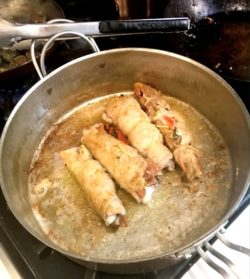 While this company supplies, in large part, the serviceware sector, Sertado Copper in Texas (with an additional
While this company supplies, in large part, the serviceware sector, Sertado Copper in Texas (with an additional 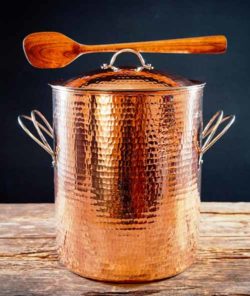 workshop in Mexico) works with a 2 mm gauge of copper (similar to what used to be called presentation weight in France.)He and his smiths hammer the copper, which creates a lovely look and also increases the tensile strength of the pan. He has designed all the handles so that you can rest a utensil on them, an endearing touch. The image at left shows how beautifully veal involtini are sauteed, with just the right amount of coloring in the butter to create a perfect sauce.
workshop in Mexico) works with a 2 mm gauge of copper (similar to what used to be called presentation weight in France.)He and his smiths hammer the copper, which creates a lovely look and also increases the tensile strength of the pan. He has designed all the handles so that you can rest a utensil on them, an endearing touch. The image at left shows how beautifully veal involtini are sauteed, with just the right amount of coloring in the butter to create a perfect sauce.
Duparquet Copper produces copper cookware made in the USA in the 1.7mm to 3mm range The iron 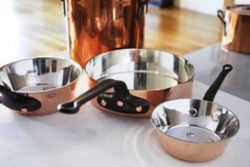 handles are more of an homage to the classic ones found on the French hotel weight copper. The owner, Jim Hamman, is unique in offering alternative silver linings (literally) to his pieces in place of tin linings. Like BCC, his company offers a retinning service for your copper. I found this video of Duparquet’s production fascinating to watch, and I think you will too. You discover the expertise and choice materials that go into the price of a pan that you buy only once.
handles are more of an homage to the classic ones found on the French hotel weight copper. The owner, Jim Hamman, is unique in offering alternative silver linings (literally) to his pieces in place of tin linings. Like BCC, his company offers a retinning service for your copper. I found this video of Duparquet’s production fascinating to watch, and I think you will too. You discover the expertise and choice materials that go into the price of a pan that you buy only once.
A couple of final thoughts on choosing pans to suit your cooking needs – don’t buy a set of pans offered at a “special price”. Sets are devised at the convenience of the manufacturer, not to suit your specific needs. This mistake I made several times and found that I was always trying to cook with a couple of pans that did not fit the recipe. As an example, I purchased a graduated set of French copper sauce pans and found that two sizes were repeatedly used and I could have used duplicates of those sizes. The other saucepans to this day, I rarely use. Do you love to make sauces, or create stove top braises and sautéed dishes? Or do you create combination roasted meals? Your answers to these questions and some thought as to how you cook and in what quantities are the best guides to what you should choose in your permanent batterie de cuisine.

Kitchen Detail shares under the radar recipes, explores the art of cooking, the stories behind food, and the tools that bring it all together, while uncovering the social, political, and environmental truths that shape our culinary world.




Hi Nancy
Mfg again as hammersmith as the stewart of fine cooking implements. Copper weights still commercial as well as capacities . Considering copper bakeware next year with pie and bake pans, basic size , tin linned in 16 or 18 ga weight . We just finished a retinning program with much success
waldow was mfg for Rugger in the beginning and when Charlie bought the 666 , he stopped paying waldow so Bruno just added B Waldow and sold to gourmet stores , ie Chuck Williams
All the best
jeff